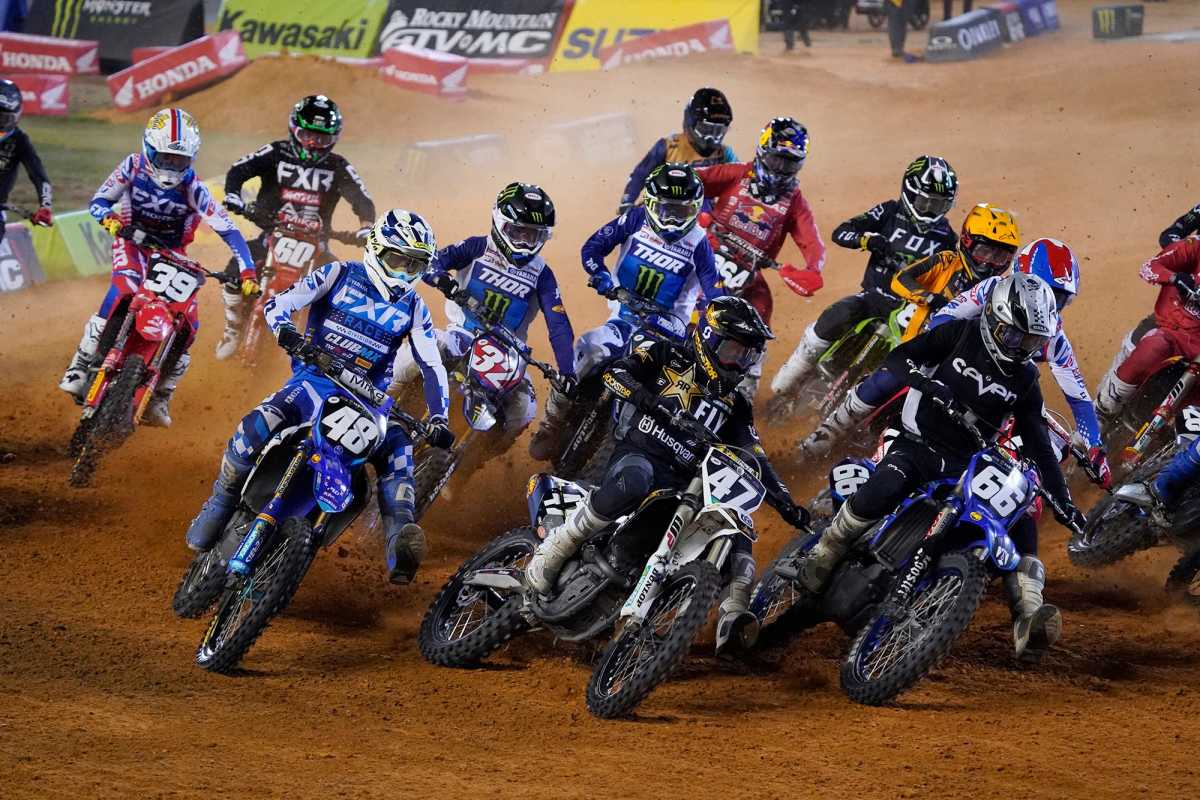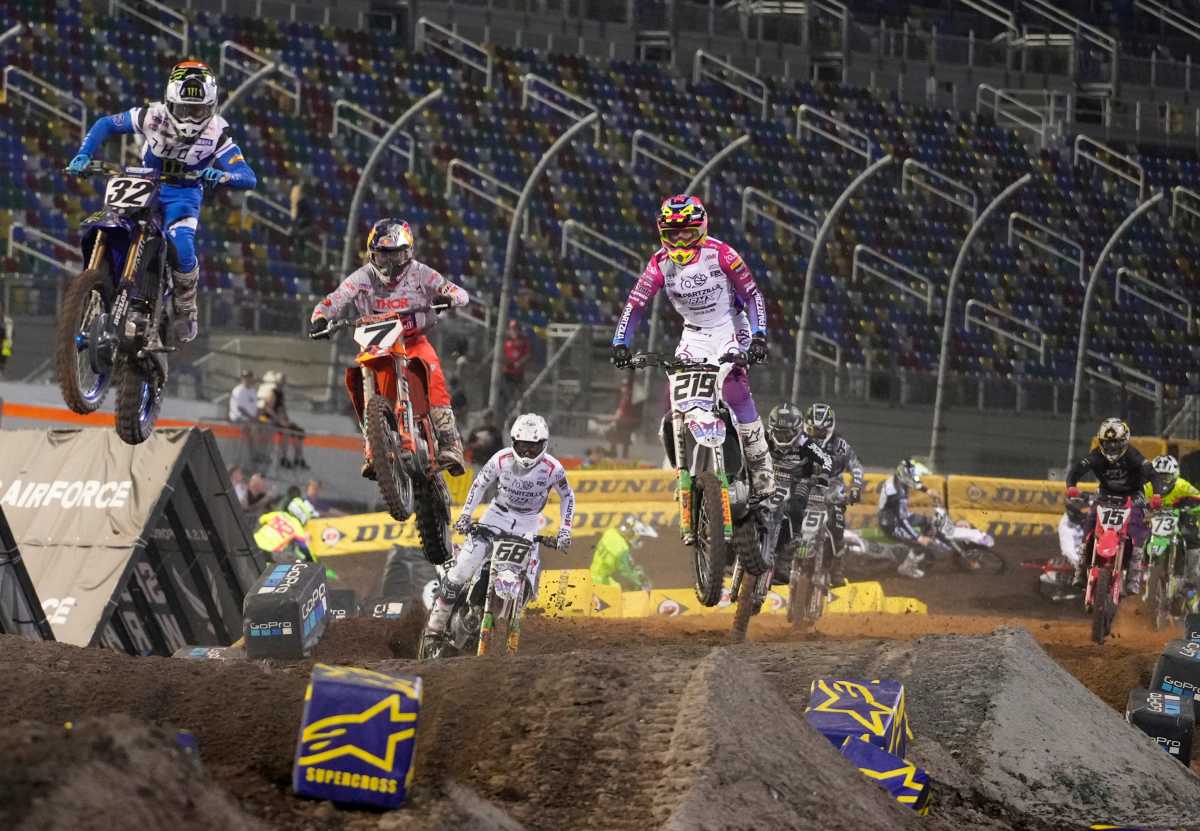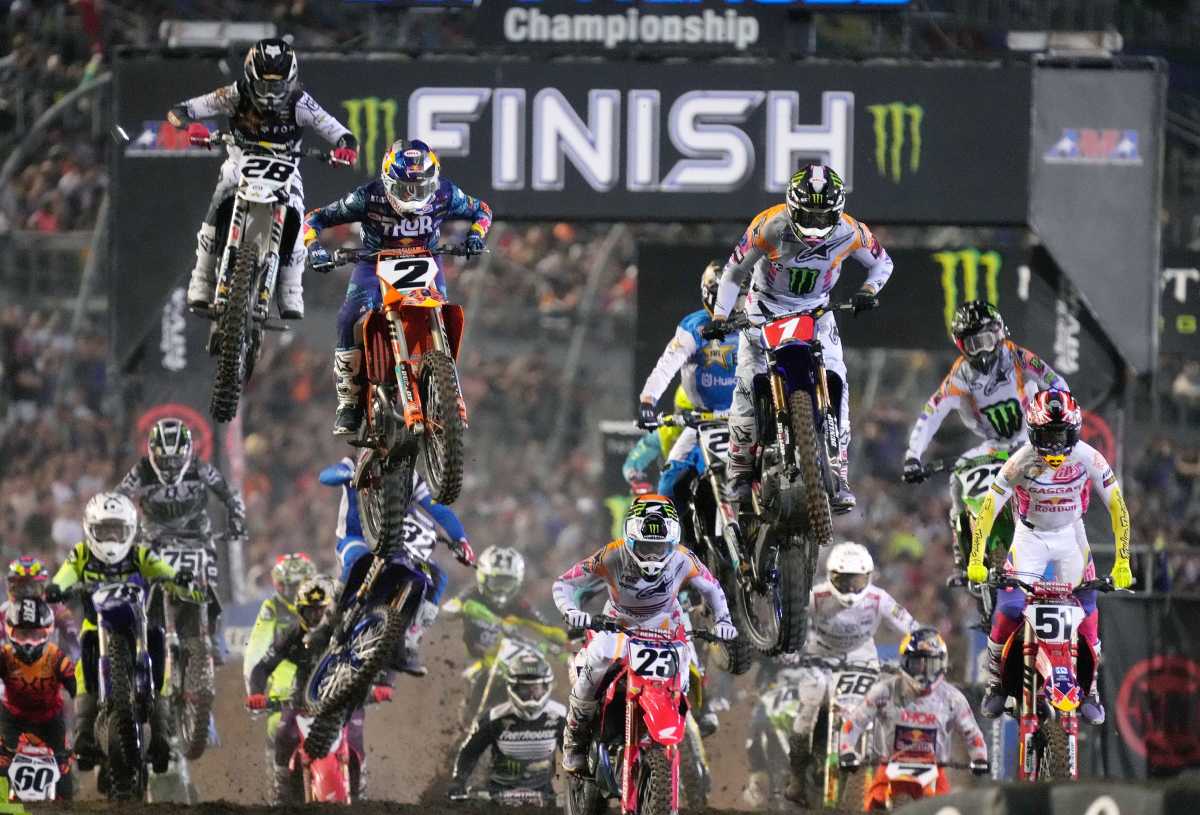A Fan’s Video Game Dream Made Him One of Two Supercross Course Designers in the World

Before someone actually paid him to design and construct supercross tracks with devious twists, ceiling-bumping jumps and harrowing turns, Mike Muye was riding dirt bikes in Pennsylvania. He started at age 5, and the hobby developed into a passion, which developed into an obsession, which developed into a … job. And not just any job. A dream job. More than, even.
“It’s pretty cool,” Muye says, “to be the only guy that does this in the world.”
Officially, Muye is the senior director of operations for Monster Energy AMA Supercross. His job is distinct, germane to one human, because of the sport he works in. Where NFL players, NBA stars and MLB teams compete primarily in home and away stadiums, motocross riders travel the country, racing on tracks they have little time to familiarize with, let alone master. This isn’t like tennis, where competitors travel the world playing various tournaments, clashing on courts with the same dimensions and surfaces and tailoring their preparations depending on whether it’s clay or grass or hard court season.
The closest comparison is golf, a sport with numerous, fluid factors like weather and course layout. Except that motocross changes are more extreme, with more variables. The important distinction is the most obvious and most existential; it’s tethered not just to the sport but to its DNA. Supercross racers are not golfers: They fly down tracks on dirt bikes, soar up to 70 feet high, turn, twist, launch, bump, accelerate, brake and reach speeds in excess of 60 miles an hour—while competing on tracks they acclimate to only minutes before any particular race.

It’s Muye’s job to torture them.
The chaos baked into competitions starts there, with no, as in zero, identical tracks. The track for Saturday’s race in Seattle is different, in design layout and obstacles, from the track in Glendale (April 8), which is different from Atlanta’s track (April 15) and the East Rutherford, N.J. (April 22), version. And, in a sport where the shifting landscape is literal, Muye even added a twist a few years back, the soul of which could be applied to other corners of the sports world. The Seattle course was designed, in part, by a supercross fan.
Consider John Blankenship the world’s most fortunate sports enthusiast. Like Muye, he came to this particular athletic endeavor early, through a family of fans who lived in the same Ohio neighborhood. All attended supercross races, analyzed favorite competitors and followed the nationwide tour online. But Blankenship felt drawn in particular to courses and their designs, which isn’t unusual for supercross fans. They can design courses on video games and with computer simulation models.
Game controls matter for proper course development, Muye says. They must be realistic. Like, for instance, with the clutch. A real-life competitor fans the clutch to keep the RPMs higher through turns, then releases it for a power burst once through. But in some simulations, there’s no fanning and releasing, which can lead to unrealistic designs. Muye describes the best models as constructed in that vein of realism, authentic to his own work, free of obstacles considered too dangerous for real races. But that doesn’t mean he’s anticreativity; in fact, he freely admits to using cool ideas from simulations on real tracks.
Sometimes, Blankenship wondered: Did he have a talent for this? Then he wondered: Did every amateur supercross course shaper feel the same way? It didn’t matter, regardless. He knew that one person, Muye, fashioned the majority of the tracks in that conniving brain of his. Blankenship also knew that retired riders like Ricky Carmichael were sometimes asked for input. Muye notes that his team will take ideas from anywhere they can find the best ones, and they’ll deploy outside resources for larger searches. (They avoid current competitors, and that’s on purpose, because they anticipate the feedback there would likely be suggestions that most benefit the person who is giving them.)
“But never,” Blankenship said, “like a regular person off the street, you know?”
Still, he had a few ideas, from the start gate to the first turn (his instinct: go big) to what’s called the Whoop section (the part with the series of small bumps). If anyone ever asked him to design a track, he knew he wanted to present multiple lines the racers could take to pass one another, thus adding choices to amplify the chaos. But Blankenship never considered that someone would actually ask for his ideas—until someone did. And that someone was Muye, not just the world’s foremost shaper of supercross tracks, but the world’s only expert in this particular endeavor.
Designing a supercross track for one of 16 races in a season works like this: Muye huddles with Dirt Wurx, the New York–based builder and exclusive tour partner; they collaborate by working up an actual blueprint at his kitchen table; and they begin with studying the empty shell of the stadium for the next event. The shell dictates many of their decisions, opening up creative possibilities in some cases while limiting them in others. Certain factors must be considered, like the placement of the finish line, where officials desire the shortest path to the exit, for safety reasons (so riders don’t have to cross the track again, inserting cross-traffic into existing chaos). Size also matters in this calculus, helping determine where to put the longer turns, the Whoop sections and the endpoint. A skeleton begins to form, as the finer details of the track are conceived around the larger framework.
The baseline: Every … single … track … is different. Even the event held in Seattle last March featured an entirely different layout than the city’s upcoming race.
The caveat: Consistency in supercross designs is found only in the obstacles that must be included. Most are typically the same or similar across all events. Triple jump loads—the height of the dirt that launches competitors—are predominantly 70 feet long. But they’re placed in different areas and feature different combinations of jumps after landing. The starting gate, meanwhile, is typically 90 feet wide on average, for about 250 feet of the track. All 22 competitors are then funneled into narrower and narrower lanes, until they near the first turn, where the width averages 20(!) feet. Designs need to incorporate getting as many racers as possible through that first turn, in what’s called “a sweeper turn,” while also retaining difficulty. That way events are decided by ability and strategy rather than crashes and dirt bike pileups early into a race. Bowl turns, the 180-degree pivots up and down large embankments, allow for passing opportunities through the different lines competitors can choose to take. (These opportunities require sharp angles, but not too sharp, so as to cause crashes.) For the self-explanatory long lanes, meanwhile, designers attempt to include at minimum five obstacles.

The process: A layer of sheet plastic is laid down, running the length of the stadium’s field. One or two layers of heavy-duty plywood rest atop the plastic. The base layer of dirt is then applied, and it’s packed as tightly as possible, until it forms the track’s foundation. Sometimes, crushed asphalt grindings are added in, which helps especially in poor weather to solidify a course. And then they fashion the actual track surface, starting with the outside lanes and working toward the center.
Picking a favorite layout isn’t quite like selecting a favorite child, Muye says. But it’s close. Almost always, there’s something to love about each track. It’s easier to note which courses didn’t work as intended. Sometimes, that owes to designs that were too intricate, others that weren’t intricate enough (“too cookie-cutter”), unforeseen stadium issues or bad luck. What matters is: How did the track race?
Roughly seven years ago, Muye commissioned a study to improve the design process. He wanted historical comparisons, for all tracks, through lab charts showing overall times, splits, jump heights, turns, the number of times one rider passed another and so forth. Muye’s team then used video footage to examine trends that bubbled to the surface. The data showed, for instance, that courses with the most passing led to “really good races.” They zeroed in on those layouts, hunting for common denominators. And they found that longer race lanes, followed by big, bold turns, tended to make passing easier for competitors. Similarly, ideal Whoop sections tended to feature moguls placed roughly 13 feet apart.
Muye was already aware of the single most common issue they uncovered: space constraints. Sometimes, desired tracks simply don’t fit within the stadium’s layout for the event, which means condensed courses. When one rider jumps over another, it might make for suspenseful television. But it also signals a course with too much traffic, forcing racers to maneuver in ways that organizers do not consider safe.
The sport, they note, is unpredictable enough as is. That’s part of the appeal, perhaps the main part for a sport that features speed, crashes, tactics, turns, weather, rivalries, friendships and decisions made in fractions of seconds that inform whether or not any particular track races well. In other words, the design matters. But even a flawless design doesn’t ensure an ideal race.
The Seattle event begins Saturday afternoon, when groups of racers partake in practice and qualifying rounds at Lumen Field, home of the Seahawks and Sounders. The racers are divided by engine power, as measured by cubic centimeter displacement (ccs) with 250cc competitors and 450cc ones.
Then—and only then—will the process of familiarization start. Retired champion Ryan Villopoto tried last week to explain what cannot be fully understood by nonparticipants. He started with the notion of “quick learners,” which, in supercross, is both a necessity and an understatement. Racers must adjust to different layouts, different surfaces to lay tracks on (natural grass, turf, concrete) and dirt consistencies (a recent event at Lucas Oil Stadium in Indianapolis featured soft dirt, which meant the bikes sunk into the track, making large ruts after only three laps). Pile on varying fields of competitors (due to high injury rates), different environments (indoor stadiums vs. outdoor ones) and different designs (Twister-like compared to versions that encourage speed), and it means the elite competitors often separate less by pure riding skill and more by their comfort level with being uncomfortable.
Fun fact: Feld Motor Sports, which runs the Monster tour, owns all its own … dirt. It’s locally sourced and stored, the supercross equivalent to a farm-to-table restaurant. A full 500 dump truck loads are required to construct a typical track, hence the dirt sourcing, which is more cost efficient and controllable.
Another, more gnarly part of the gig: With all the differences in every city, competitors are allowed a short walk on the track to ascertain whatever they can visually. Villopoto, for instance, would scour for jump heights and tweak his plan accordingly. They can also make adjustments to their bikes, for everything from suspension or shock-absorption levels to cracked frames. But that’s it. They walk, they head backstage, they dress and they head back in. Then they’re allotted three rounds of practice, none longer than 10 minutes, on their bikes to acclimate. And then the rounds that count begin, at full, breakneck speed, with crowded turns, massive launches and precious little prep time.

Skill sets factor into preparations. Villopoto wasn’t an elite jumper on his dirt bike, especially judging new jump configurations. So during his practice rounds, in those moments when he thought, holy s---, we’ve got to jump this, he would follow a competitor over the jump in his practice laps, hoping to glean the right approach. When he found it, he could push faster at that point in that race, which often marked the difference between good and poor performances.
The other relevant factor for competitors that Villopoto laid out is how tracks change over the course of a race. This stems primarily from the dirt surface, which shifts and changes due to wear—from crashes, laps and nonstop motion. The main event, for example, is decided by the most laps completed in 20 minutes, with top competitors averaging between 50 seconds and 55 seconds per lap. But in those upward of 24 laps, no two times around the track will present exactly the same set of factors, meaning riders adjust in real time, too, to a course they already don’t know super well.
Villopoto loved the fan involvement twist, which signaled more engagement for what he calls the “highest form of dirt bike racing.” The sport already leaned into the fan experience, with pit visits and course tours (in addition to the video games that enable fans to build virtual tracks) that bring diehards so close to the action they could smell, touch and hear the experience up close.
The design that Blankenship cooked up intrigued Villopoto—specifically, the giant, sweeping, stadium-floor-length opening turn. Competitors with slower qualifying times are likely to end up bunched on the outside, meaning they’ll have to travel farther and, depending on the size of the bunch, avoid more of their fellow riders. Villopoto also pays especially close attention to the start because of the small dogleg left out of the sand section. It’s unusual, he said, because it calls for more early maneuvering, which is “gonna promote some good racing.” Villopoto also noted the length of the Whoop sections, which appeared longer than normal and seemed likely to factor into podium finishes based on which racers excelled at traversing them.
Muye liked the sand section in particular, calling it “the great equalizer,” because it’s loose and shifts as the competition unfolds. He also saw those desired bold turns to uptick passing.
This is precisely what Muye hoped for when Monster began soliciting fan designs about three years ago. The inventions sparked creativity and innovation, plus the idea bolstered engagement on social media. This is precisely how Blankenship came across the contest; when he decided to enter, he knew he wanted his design to be realistic, because he figured most were eliminated by not being practical or being too dangerous alone. His design didn’t take him long at all to put together. After entering, he sort of forgot about the competition, until he received a message from the event organizers. He had won.
Blankenship will be in attendance when his track is brought to life, his presence one perk of winning the contest. He’s still processing. “It’s starting to hit me that we’re actually going to watch my track, like, be raced on,” he says.
The question all three consider from different vantage points is whether the fan influence in supercross can be applied to other sports. Muye, the designer, doesn’t think so, because the dimensions of fields of play in other sports can’t change. Blankenship wonders whether those other sports could apply the soul of the exercise to things like rules. In the NFL, for instance, what constitutes a catch? That sentiment concerns Villopoto, who worries about opening a Pandora’s box of fandom, for the reasonable and unreasonable alike.
Blankenship’s next question: When does Muye plan to retire? After all, having tasted perhaps the most distinct job in sports, he might apply.
